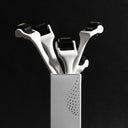Hair loss is a normal physiological event in an individual's life. However, the loss of more than 100 strands per day can become a cause for concern.
Telogen effluvium is a condition where one suffers from excessive amounts of hair falling out with the white bulb at the root (or hair at the telogen phase). Multiple trigger factors are responsible for the onset of telogen effluvium.
Table of content
Why is my hair falling out with white bulb?
When you notice hair falling out with a white bulb at the end, it typically indicates that the hair has gone through its natural growth cycle and has been shed during the telogen phase. The white bulb is the hair root or the dermal papilla, which is the base of the hair follicle that supplies nutrients for hair growth.
The hair growth cycle has three main phases:
Anagen phase
This is the active growth phase, which can last from 2 to 7 years. During this period, the hair grows about 1 cm per month.
Catagen phase
This is a short transitional phase, which lasts around 2 to 3 weeks. During this time, the hair follicle begins to shrink, and hair growth slows down.
Telogen phase
This is the resting phase, which lasts for about 3 months. During this time, the hair follicle is inactive, and old hair is shed to make room for new hair growth.
Losing 50 to 100 hairs per day with a white bulb is considered normal and part of the natural shedding process.
However, if you notice excessive hair shedding with a white bulb, it might be due to factors such as:
- Stress
- Hormonal changes or imbalances
- Nutritional deficiencies
- Certain medications
- Health conditions like thyroid disorders or anemia
- Over-styling or using harsh hair care products
As your leading source for hair health information over the past 4 years, we never compromise on accuracy. When it comes to your health, you deserve information you can truly rely on - and earning your trust is our top priority.
Here's how Scandinavian Biolabs ensures every piece of content meets the highest standards of accuracy and integrity:
- Credentialed Experts: Our reviewers are actively practicing doctors and medical researchers
- Stringent Reviews: Content undergoes rigorous editing by subject specialists and review by a practicing doctor.
- Evidence-Based: We rely on well-established research from trusted scientific sources like peer-reviewed journals and health authorities.
- Full Transparency: Our editorial standards, writer credentials, reviewer credentials, correction process, and funding are all publicly documented.
- Independent Voice: While we do promote products, we operate in a vacuum to business operations. Our main goal is just an unwavering commitment to providing medically-sound guidance.
You can count on Scandinavian Biolabs to consistently deliver the trustworthy health information you deserve. Read our Editorial Standards.
What is the white bulb at the end of hair?
The white bulb at the end of a hair strand is the hair root or the dermal papilla. The dermal papilla is located at the base of the hair follicle and is responsible for supplying the necessary nutrients for hair growth.
The presence of the white bulb on a shed hair typically indicates that the hair has gone through its natural growth cycle and has been released during the telogen phase, which is the resting stage of the hair growth cycle.
When you see a white bulb on a shed hair, it generally means that the hair ha
What does white bulb on hair mean?
When you see a white bulb on a shed hair, it generally means that the hair has completed its life cycle and has been naturally shed to make room for new hair growth.
Shedding 50 to 100 hairs per day, with or without a white bulb, is considered normal and part of the natural hair shedding process.
However, if you notice excessive hair shedding with a white bulb, it might be due to factors such as stress, hormonal changes, nutritional deficiencies, certain medications, health conditions, or harsh hair care practices.
In such cases, it's essential to consult a dermatologist or healthcare professional to determine the cause and recommend appropriate treatments or lifestyle adjustments.
One culprit to hair falling out with the white bulb: Telogen effluvium
Telogen effluvium is among the most common scalp disorders predominantly affecting the female population. This form of alopecia is characterized by non-scarring, diffuse, and excessive hair shedding.
Most of the hair loss cases are subclinical and do not come to physicians' and/or patients' attention. Telogen effluvium also affects certain age groups: older groups are more susceptible to telogen effluvium than younger individuals.
Acute telogen effluvium refers to hair shedding that lasts for less than six months. The onset of hair shedding is noticeable about two to three months after the exposure to a stressor, however, remission is seen in approximately 95% of the telogen effluvium cases.
Hair loss associated with pregnancy is one form of telogen effluvium, also known as telogen gravidarum.
On the contrary, chronic telogen effluvium occurs when hair shedding exceeds six months. This mostly occurs in middle-aged women and presents as a prolonged fluctuating form of hair loss.
The resolution of chronic telogen effluvium is indicated by the regrowth of hair in frontal and temporal regions of the scalp with normal thickness. Most of these cases are idiopathic.
Telogen effluvium arises due to disruption of the hair growth cycle and may be triggered by intrinsic and extrinsic stressors. The five probable mechanisms of shedding in telogen effluvium are listed below.
Immediate Anagen Release
This mechanism of hair shedding is characterized by premature progression of follicles from the anagen to the telogen phase of the hair cycle. This is followed by extensive hair shedding two to three months after the stressful event.
Delayed Anagen Release
This mechanism implies an increased duration of the anagen phase of the hair cycle. This is followed by excessive hair loss in the telogen phase.
Short Anagen Syndrome
This is characterized by a shorter duration of the anagen phase that results in persistent telogen effluvium. This is also considered the underlying mechanism of chronic telogen effluvium.
Immediate Telogen Release
As indicated by the name, immediate telogen release is referred to a shorter telogen phase and massive shedding of club hair.
Delayed Telogen Release
This is characterized by the shortening of the telogen phase of the hair growth cycle causing the hair follicles to progress to the anagen phase at a relatively slower rate.

PATTERNS OF TELOGEN EFFLUVIUM
What are the causes of telogen effluvium?
Below are the different triggering factors that disrupt the hair growth cycle and give rise to telogen effluvium.
Drugs
Medications may be associated with hair shedding during the telogen phase, approximately 12 weeks after the intake of drugs. These drugs may include angiotensin-converting enzyme inhibitors, oral contraceptive pills, anticoagulants, antidepressants, and anticonvulsants.
Physiological Stress
Physiological stress may cause a large volume of hair follicles to progress into the telogen phase. These stressors include high-grade fever, surgical trauma, hemorrhage, chronic systemic illness, and childbirth. The onset of telogen gravidarum occurs three months post-partum.
Medical Conditions
Hyperthyroidism, hypothyroidism, autoimmune disorders, inflammatory conditions, systemic amyloidosis, renal failure, and hepatic failure may also give rise to telogen effluvium.
Dietary Factors
Dietary deficiencies may trigger the onset of telogen effluvium. Fatty acid, zinc, protein, iron, vitamin D, and biotin or vitamin B7 deficiencies may lead to telogen effluvium. Caloric restriction, as well as chronic starvation states, may also bring about telogen effluvium.
Read more: Fasting Hair Loss: Definition, Causes and Treatment Options
Ultraviolet Radiation
Increased exposure to solar UV radiation causes damage to the hair follicles and hair strands. This disrupts the hair growth cycle and leads to the excessive shedding of hair.
How do you treat telogen effluvium?
Telogen effluvium can be considered a sign related to underlying conditions rather than a discrete disorder.
Acute telogen effluvium is a self-limited hair loss condition. This resolves upon withdrawal of the triggering factor(s). Medications associated with hair loss should be discontinued and scalp conditions must be treated.
Chronic telogen effluvium treatment requires the identification and elimination of multiple triggering factors responsible for eliciting hair loss during the telogen phase.
However, if you still want to minimize the chances of your hair falling out with the white bulb, there are some hair restoration methods you can try:
The Bio-Pilixin® Activation Serum
If you want a more budget-friendly but just as effective solution to telogen effluvium, we only have rave reviews for this hair serum.
The Bio-Pilixin® Activation Serum is a trademarked hair serum that stimulates new hair growth and helps reduce hair fall using only clean ingredients like:
- Turmeric - to improve hair density
- Niacinamide - to increase keratin levels
- Aloe vera - to improve scalp hydration
The Bio-Pilixin® Activation Serum is also tested by an independent third party, which found that it has an efficacy rate of 93% and is proven to reduce hair loss by 83%.
Read all about the study here.
Product promises shouldn't be taken lightly and to assure you that the Bio-Pilixin® Activation Serum does indeed deliver, all product users get their money back if it doesn't work after 150 days!
Consultation
Look up reliable online resources about hair loss to know more. You can also consult with a hair expert to manage excessive hair loss or hair thinning due to telogen effluvium.
Diet
Dietary deficiencies might cause hair breakage and thinning hair. It's important to consume a healthy diet for healthy hair and hair regrowth.
To ensure that you're getting the nutrients you need to strengthen your hair, we suggest Scandinavian Biolabs' Hair Nutrient Tablets, complete with hair-boosting extracts like:
- Apple extract - to stimulate anagen hair growth
- Amino acid complex - to boost keratin levels in hair
- Horsetail extract - to improve tensile strength of hair strands
- Vitamin B - to promote healthy red blood cells for hair growth
- Vitamin C - to reinforce the structure of hair follicles
But that's not even the best thing! These tablets are 100% vegan and lab-tested to deliver effective results!
Medication
If you currently have other health conditions and are taking medicine associated with hair loss, consult with your doctor about your medications to see if there are any alternatives you can take.
Catagen-inducing medications including beta-blockers, antithyroid, anticoagulants, and retinoids are only some of the culprits when it comes to increased hair loss.
Meanwhile, catagen-inducing disorders including thyroid abnormalities and androgen disorders should be treated to resolve telogen effluvium.
However, neither minoxidil nor finasteride neither inhibit the catagen phase nor induce the anagen phase of the hair cycle.
Corticosteroids
The application of topical corticosteroids reduces trichodynia among telogen effluvium patients. Topical corticosteroids reduce pain, tenderness, itching, and burning of the scalp, and are indicative of effective treatment of telogen effluvium.
Systemic administration of corticosteroids treats telogen effluvium in patients suffering from systemic medical conditions.
CNDPA therapy
CNDPA therapy includes caffeine, niacinamide, panthenol, dimethicone, and acrylate polymer. This combination therapy boosts the scalp hair density in patients suffering from telogen effluvium.
Hair transplant
Hair transplant is also a great option if you want to permanently treat your male pattern or female pattern hair loss.
However, hair transplants are costly and comes with its set of risks and cons, like the rejection of donor hair or severe scalp irritation.
Read more:
- Does Collagen Help Hair Loss? What You Need to Know (2022)
- I Can See My Scalp through My Hair: What To Do?
- Hair Miniaturization: Definition, Causes & Treatments
References
- https://www.ncbi.nlm.nih.gov/books/NBK499948/
- https://www.sciencedirect.com/topics/medicine-and-dentistry/hair-growth
- https://www.karger.com/Article/Fulltext/460300
- https://www.aad.org/public/diseases/hair-loss/insider/shedding
- https://www.ncbi.nlm.nih.gov/labs/pmc/articles/PMC6709511/
- https://www.ncbi.nlm.nih.gov/labs/pmc/articles/PMC2938572/#CIT5
- https://www.ncbi.nlm.nih.gov/labs/pmc/articles/PMC7320655/
- Medical, Surgical, and Cosmetic Treatments, Second Edition, Edited ByAmy J. McMichael, Maria K. Hordinsky










